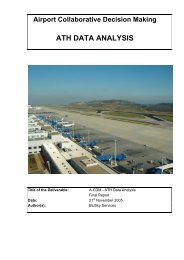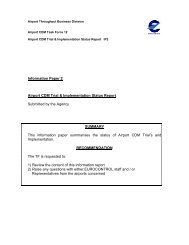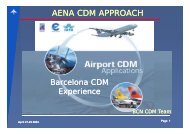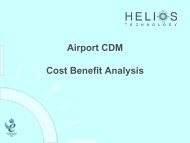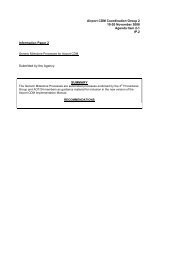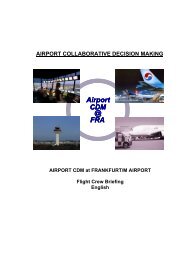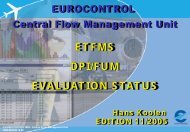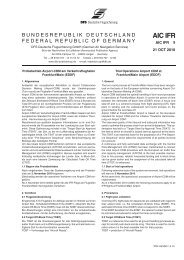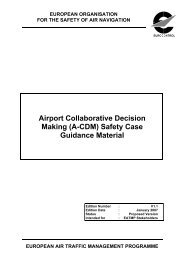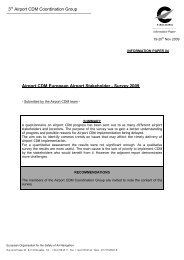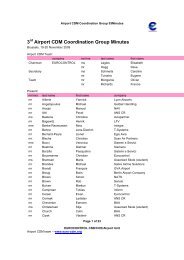Generic Operational Concept for DMAN Interaction v07A - Airport ...
Generic Operational Concept for DMAN Interaction v07A - Airport ...
Generic Operational Concept for DMAN Interaction v07A - Airport ...
Create successful ePaper yourself
Turn your PDF publications into a flip-book with our unique Google optimized e-Paper software.
<strong>Generic</strong> <strong>Operational</strong> <strong>Concept</strong> <strong>for</strong> Pre-departure Runway Sequence Planning and<br />
Accurate Take-Off Per<strong>for</strong>mance<br />
Enabled by <strong>DMAN</strong> interaction with <strong>Airport</strong> CDM and A-SMGCS concepts<br />
Taxi-Out<br />
Once the flight has left the stand, the take-off sequence should be fixed, in order to avoid<br />
instable sequence in<strong>for</strong>mation to controllers and aircraft operators. In case of de-icing on<br />
the plat<strong>for</strong>m, the taxi time may be adjusted accordingly, or the fixing of the runway<br />
sequence postponed after the de-icing event.<br />
Although at some airports a dynamic update of the take-off sequence may be proposed<br />
by a Surface Manager tool (SMAN), experience from experiments learns that controllers<br />
prefer a stable sequence which they consider a reference or target. Dynamic changes of<br />
the traffic situation will be considered by them in order to deviate from the sequence, or<br />
find creative ways to meet the planning.<br />
Aircraft Operators should receive stable take-off sequence in<strong>for</strong>mation in order to be<br />
able to evaluate per<strong>for</strong>mance with ATC, and develop faith in the concept and the<br />
controllers aim to achieve planning where possible. In section 2.4.2.3 more is explained<br />
how deviation from the planned sequence should be detected and fed back into the<br />
<strong>DMAN</strong> planning of other flights still in their turnround process.<br />
This network perspective through different stages of the flight turnround reflects the<br />
interaction of <strong>Airport</strong> CDM, A-SMGCS and <strong>DMAN</strong> with CFMU to in<strong>for</strong>m on flight<br />
progress. The process of interacting <strong>Airport</strong> CDM, A-SMGCS and <strong>DMAN</strong> is further<br />
elaborated in the next section with a cockpit oriented perspective.<br />
2.4.7 Flight Crew Perspective<br />
Flight crew execution of start-up procedure <strong>for</strong> pushback and taxiing to the runway has<br />
large impact in execution of the pre-departure off-block and runway planning. Flight<br />
crew is able to realise or disturb the planned sequence be<strong>for</strong>e and during pushback as<br />
well as the taxi-out phase. To a large extent they have control over departure execution<br />
according to planning, however many disturbing factors exist and may occur.<br />
The flight crew has the final decision whether the aircraft is ready <strong>for</strong> off-blocks, or<br />
requires extra time <strong>for</strong> procedures, de-icing, or other delaying factors. Hence, they are in<br />
the position to decide to last minute delay, and need there<strong>for</strong>e to communicate to their<br />
operation control centre and <strong>Airport</strong> CDM partners. For that purpose of last minute<br />
handling, flight crew must have the ability to influence the <strong>Airport</strong> CDM process with an<br />
update of TOBT in such exceptional circumstances, especially close to the TSAT time<br />
when unexpected events have the greatest impact on the stabilised pre-departure<br />
sequence.<br />
During taxi-out the flight crew can also influence the arrival time at the runway, by<br />
varying taxi speed or taking the wrong taxi route. Especially <strong>for</strong> this taxi-out phase future<br />
A-SMGCS improvements are expected to contribute to more guidance of the flight crew,<br />
e.g. by using an Electronic Flight Bag (EFB) or Cockpit Display of Traffic In<strong>for</strong>mation<br />
(CDTI) where the taxi route derived by the A-SMGCS can be presented via datalink to<br />
the flight crew, amongst other relevant flight in<strong>for</strong>mation. See also Figure 8 <strong>for</strong> a detailed<br />
view of cockpit displays <strong>for</strong> taxi routing.<br />
Page 21 of 29<br />
EUROCONTROL HQ, Cooperative Network Design, Centre of Expertise, <strong>Airport</strong>s Unit



